 Website:
Max Bögl
Website:
Max Bögl
Group: Max Bögl Group
Catalog excerpts

Outstanding Roof Structures Progress is built on ideas.
Open the catalog to page 1
Johann Bögl Today modern construction – from planning, implementation right through to warranty transfer – means more complex projects, more elaborate technologies, ever decreasing implementation timeframes and hence increasingly fierce competitive conditions. The Max Bögl Group with its building construction division has not been spared from these drastic changes either, changes which have been further exacerbated as a result of the worldwide economic crisis. Whilst in past years building construction requirements were restricted for the most part to the carcass work and related concrete,...
Open the catalog to page 3
Widespan Roofs as a turnkey solution When giants of sports meet and stars are revered – fans give vent to their feelings in front of millions of spectators: being there inside the world’s biggest and most magnificent sports arenas – victory and defeat – experienced from close quarters. In the past a symbol of selfawareness and public representation, today’s modern arenas are locations with a special sensational character. They provide the stage for the mass media and commercial activities. Mainly built for world events, such as the Olympic Games or World Championships, these arenas generate...
Open the catalog to page 4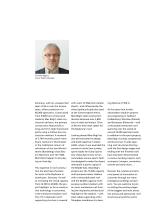
Christian Eggert, Senior Project Manager Germany, with an unsupported span of 65 m over the terrace seats, offers protection for 66,000 spectators. Constructed from 9,000 tons of steel and made by Max Bögl’s steel construction division, the primary construction features 65 mlong and 10 m-high framework joints using a hollow box construction method. A net ork w of 2,784 rhombic plastic membrane cushions is illuminated in the traditional colours of whichever of the two Munich teams (Bundesliga clubs Bayern München and TSV 1860 München) happen to be playing on that day. This expertise in roof...
Open the catalog to page 5
Consultation and Planning As a service provided to the building contractor, the Max Bögl Group, with its own engineering and manufacturing capacities, takes charge of steel structures of any size at its Neumarkt location. It is primarily the close contact between the divisions at Max Bögl that produces comprehensive planning services on a highly technical level. This relates to the divisions of steel construction, transportation and assembly, as well as the divisions of precast concrete parts and turnkey well as the execution of steel constructions, demonstrating construction works by means...
Open the catalog to page 8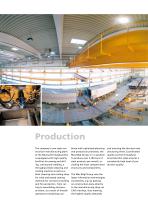
Production The company’s own steel construction manufacturing plant at the Neumarkt headquarters is equipped with high-quality facilities for sawing and drilling, cutting and welding, a throughput blast cleaning and coating machine as well as a blast cleaning and coating shop for tried and tested coating methods for corrosion proofing and fire protection. From cutting to assembling and preservation, as a result of smooth operations scheduling com- bined with optimized planning and production processes, the Max Bögl Group is in a position to produce over 2,100 tons of steel products per...
Open the catalog to page 10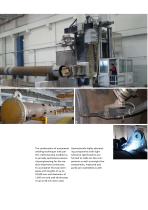
The combination of automated welding techniques with perfect craftsmanship enabled us to provide optimized pressure ring engineering for the stadium BayArena Leverkusen. To accomplish this task steel pipes with lengths of up to 18,500 mm and diameters of 1,016 mm and wall thicknesses of up to 50 mm were used. Geometrically highly demanding components with tight tolerance specifications are formed to make art-like components as well as straight line components, measured and partly pre-assembled as well.
Open the catalog to page 12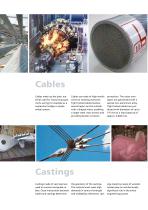
Cables Cables make up the basic material used for many long-span roofs, acting for example as a suspension bridge or spoke wheel system. Cables are made of high-tensile wires on twisting machines. Tight locked cables feature several layers on the outside with z-shaped wires, enabling a larger steel cross section and providing better corrosion protection. The outer wire layers are galvanized with a special zinc-aluminium alloy. Tight locked cables are produced with diameters of up to 175 mm at a load capacity of approx. 4,000 tons. Castings Castings made of cast steel are used to connect and...
Open the catalog to page 14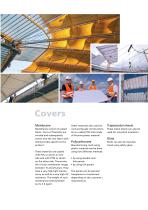
Covers Membrane Membranes consist of coated fabric. Yarns of filaments are twisted and subsequently woven into the raw fabric with linking modes specific to the product. These materials are coated with PVC or silicon on one side and with PTFE or silicon on the other side. The service life of such membranes ranges between 15 and 25 years. They have a very high light translucency as well as a very high UV resistance. The weight of such membranes varies between 0,2 to 1,5 kg/m². Other materials also used for roof and facade constructions are so-called ETFE foils made of fluorine plastic...
Open the catalog to page 15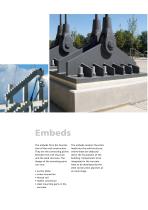
Embeds The embeds form the foundation of the roof construction. They are the connecting points between the roof structure and the solid structure. The design of the mounting parts can vary: • anchor plate • screw connection • thread rod • Halfen connection • s teel mounting parts in the The embeds conduct the static loads into the solid structure, where these are deduced down the foundation of the building. Components to be integrated in the concrete have to be developed by the steel construction planners at an early stage.
Open the catalog to page 16
Steel construction mounting RheinEnergieStadion, Cologne The individual roofs sailing above the stands are suspended along their centre line to support terrace areas without the spectators’ free view being obstructed in any way. The vertical roof loads are transferred to the outside via the supporting main guy cables to the four pylons located at the stadium‘s corners, each 66 m in height and 375 t in weight, where they cross at the column heads at two levels. The framework pressure bars are suspended on the tight locked supporting cables up to 200 m in length and 85 mm in thickness at...
Open the catalog to page 18All Max Bögl catalogs and technical brochures
-
Slab Track China
12 Pages
-
European Championship
12 Pages
-
Commerzbank Arena Frankfurt
12 Pages
-
BayArena Leverkusen
8 Pages
-
Audi Dome, Munich
8 Pages
-
Arena Varazdin
8 Pages
-
ARENA NÜRNBERGER
8 Pages
-
Al Maktoum International
8 Pages
-
Strelasundquerung
12 Pages
-
MGB - Maglev Guideway Bögl
20 Pages
-
Max Bögl Hybrid Tower System
28 Pages
-
Machines made of Concrete
8 Pages
-
Environmental Policy
2 Pages
-
Quality Standard
28 Pages
-
Value management
20 Pages
-
People. Building. Visions.
48 Pages
-
Light Rail Bögl
20 Pages
-
Slab Track Bogl
28 Pages
-
BÜB - Level Crossing Bögl
8 Pages
-
BSB - Concrete Sleeper Bögl
4 Pages
-
architectural concrete
8 Pages
-
Infrastructure Progess
40 Pages
-
Pre-cast Concrete Elements
32 Pages
-
Building construction brochure
40 Pages






























